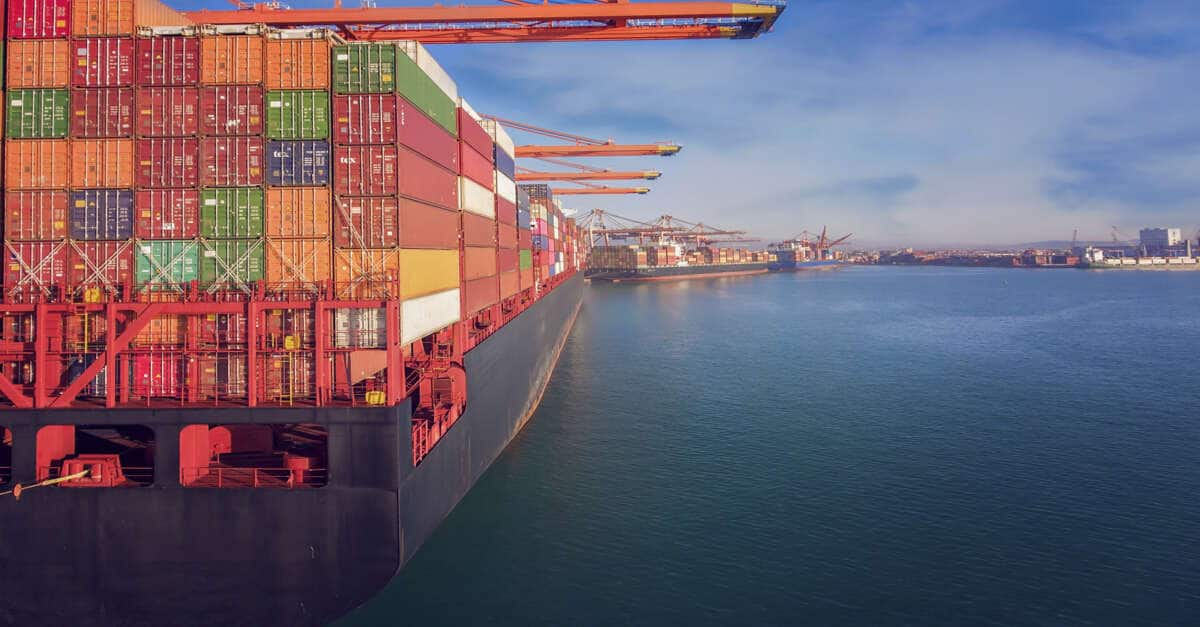Customer Logins
Obtain the data you need to make the most informed decisions by accessing our extensive portfolio of information, analytics, and expertise. Sign in to the product or service center of your choice.
Customer Logins
BLOG
Oct 09, 2023
Sustainability at sea: Port performance and emissions
Ships can sometimes wait many hours or even days to enter a port, generating emissions all the while and wasting valuable time that could be used to go slower on subsequent journey legs to burn less fuel. The industry is taking steps to reduce these wait times as well as speed up cargo loading and unloading and ship departure processes to get closer to emissions targets — saving money and improving customer satisfaction in the process.
Estimates vary on how much international shipping contributes to carbon dioxide (CO2) emissions. Organizations like the International Maritime Organization, the United Nations, and the European Commission puts international shipping at somewhere between 2% and 3% of global CO2 emissions.
While that doesn't seem like a huge percentage, the rapid growth in demand for international shipping means maritime emissions are growing at a faster rate than most other sectors. In 2021, we had a year-over-year growth in emissions of almost 5%. The global port congestion that year was one of the main causes of that steep increase. Given the growth in shipping demand, if everything were to stay the same, the industry could be responsible for as much as 15% or more of global emissions by 2050.
The IMO targets are a 40% reduction in carbon intensity of international shipping by 2030 compared with 2008 and to reach net-zero greenhouse gas emissions by or around 2050. That reduction will come from a mix of design, economic and operational solutions, including optimizing vessel speeds, which depends heavily on better network and port call efficiency to reduce waste in the time for vessels to call at ports (vessel turnaround time).

Container Port Performance
Container Port Performance is the analysis of port efficiency with the primary goal of improving vessel turnaround time. Vessel turnaround time includes the time it takes to complete vessel arrival and berthing processes; the start of cargo operations; cargo loading and unloading, and the processes for departure from the port. Port Call Optimization involves developing and applying solutions based on those insights, reducing inefficiencies through process improvements and new technologies to make the vessel call as predictable and as timely as possible, with the ultimate goal of just-in-time vessel arrival.
Learn more about our port performance program
Reducing negative environmental impact is one of the biggest drivers of Port Call Optimization. That reduction comes mainly from opportunities for vessel operators to use time saved in port, and more predictable port operations in general, to control speeds and therefore reduce fuel burn, and to consequently reduce emissions. When you have very inefficient port call processes — with excessive time spent waiting for berths, for example — vessels may need to increase speed to try and maintain schedules, which results in increased fuel consumption and emissions. Each wasted hour in port can be linked to a certain number of metric tons of fuel and associated costs and emissions.
Absence of shared information is one of the primary causes of waste in port calls. Digitization is the antidote to this; it is the key to better efficiency and to the ultimate and highly challenging goal of system-wide just-in-time vessel arrivals. Port operations are very complex and produce large amounts of data. Digitization can ensure these data are recorded and utilized effectively, creating access to critical information at the right time, which in turn drives better collaboration and better synchronization of efforts between the different stakeholders in the port call ecosystem.
Listen to our podcast to learn more
Developing standards
The development of standards is a critical building block for industry digitization. Work in this area is being done by organizations such as the Digital Container Shipping Association. There also needs to be a mindset change that supports collaboration and sharing of information. There can be reluctance to have more transparency between the participants in the various processes.
Other benefits of tracking Port Performance include increased safety and better customer experience. Better schedule integrity — more predictable and timely arrival of vessels— reduces the potential for supply chain disruption. Shipping liner services are set up like bus services or train services: they normally run on weekly frequencies through fixed rotations of ports. Right now, the system is not providing the predictability and reliability that this model is supposed to deliver. Governments and consumers became very aware of that after the pandemic triggered the global port congestion and then the heavy disruption that we saw to supply chains.
There's a very direct relationship between port delays and congestion and delays in supply chains. Conversely, there's a clear link between efficient gateway ports and terminals and efficient supply chains. The supply chain benefits and the reduced risks for the global trading economy are also very evident.
Reducing maritime emissions is an important part of global
emissions reduction, especially considering the rapid growth of the
sector and the potential for delays and congestion in ports that we
saw in recent years. Making global liner operations more efficient,
particularly port calls, is one of the key levers to do that. To
achieve these goals, greater focus is needed on performance,
including measuring, tracking, and benchmarking port call
processes. Industry digitization can drive these improvements and
enhance collaboration and coordination among the different
stakeholders. The good news is that the building blocks are in
place and these goals are achievable.
Learn more about our data and
insights
This article was published by S&P Global Market Intelligence and not by S&P Global Ratings, which is a separately managed division of S&P Global.
{"items" : [
{"name":"share","enabled":true,"desc":"<strong>Share</strong>","mobdesc":"Share","options":[ {"name":"facebook","url":"https://www.facebook.com/sharer.php?u=http%3a%2f%2fstage.www.spglobal.com%2fmarketintelligence%2fen%2fmi%2fresearch-analysis%2fgreen-port-performance-emissions-reduction.html","enabled":true},{"name":"twitter","url":"https://twitter.com/intent/tweet?url=http%3a%2f%2fstage.www.spglobal.com%2fmarketintelligence%2fen%2fmi%2fresearch-analysis%2fgreen-port-performance-emissions-reduction.html&text=Sustainability+at+sea%3a+Port+performance+and+emissions+%7c+S%26P+Global+","enabled":true},{"name":"linkedin","url":"https://www.linkedin.com/sharing/share-offsite/?url=http%3a%2f%2fstage.www.spglobal.com%2fmarketintelligence%2fen%2fmi%2fresearch-analysis%2fgreen-port-performance-emissions-reduction.html","enabled":true},{"name":"email","url":"?subject=Sustainability at sea: Port performance and emissions | S&P Global &body=http%3a%2f%2fstage.www.spglobal.com%2fmarketintelligence%2fen%2fmi%2fresearch-analysis%2fgreen-port-performance-emissions-reduction.html","enabled":true},{"name":"whatsapp","url":"https://api.whatsapp.com/send?text=Sustainability+at+sea%3a+Port+performance+and+emissions+%7c+S%26P+Global+ http%3a%2f%2fstage.www.spglobal.com%2fmarketintelligence%2fen%2fmi%2fresearch-analysis%2fgreen-port-performance-emissions-reduction.html","enabled":true}]}, {"name":"rtt","enabled":true,"mobdesc":"Top"}
]}





